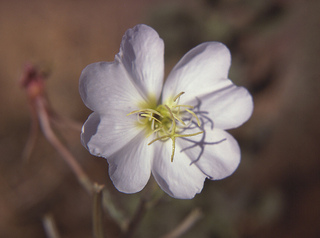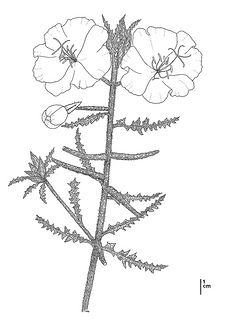(Oenothera deltoides ssp. howellii)
 Oenothera deltoides ssp. howellii. Photo © Charles Patterson.
Oenothera deltoides ssp. howellii. Photo © Charles Patterson.
 Oenothera deltoides ssp. howellii. CDFW illustration by Mary Ann Showers. (Click to enlarge)
Oenothera deltoides ssp. howellii. CDFW illustration by Mary Ann Showers. (Click to enlarge)
Antioch Dunes evening-primrose is a California endangered plant species, which means that killing or possession of plants collected from the wild is prohibited by the California Endangered Species Act (CESA). Antioch Dunes evening-primrose is a short-lived perennial plant found at the Antioch Dunes National Wildlife Refuge. The plant has large white flowers that open in the early evening and close in the morning, and it blooms from March to September. Antioch Dunes evening-primrose requires pollinators to reproduce, relying mostly on bees. Like many evening-primrose species, Antioch Dunes evening-primrose grows in mostly pure sand, but unlike other species, it will only re-establish in areas that contain new sand. Antioch Dunes evening-primrose is also listed as endangered by the federal Endangered Species Act.
The only naturally-occurring populations of Antioch Dunes evening-primrose are in the Antioch Dunes National Wildlife Refuge, which has been designated as Critical Habitat for Antioch Dunes evening-primrose by the U.S. Fish and Wildlife Service. It is difficult to determine the extent of the species’ historic range because surrounding suitable habitat was probably altered before the plant was discovered elsewhere. There have been several successful introductions of Antioch Dunes evening-primrose in Tilden Regional Park and Brannan Island State Recreational Area. As part of the Antioch Dunes National Refuge Comprehensive Conservation Plan, Antioch Dunes evening-primrose populations are monitored each year. According to the U.S. Fish and Wildlife Service Five Year Review completed in 2008, there were approximately 800 Antioch Dunes evening-primrose plants throughout its range in 2007, and populations were not entirely self-sustaining.
Originally, Antioch Dunes evening-primrose habitat was destroyed by urban development, sand mining, and agricultural conversion. Today, habitat alteration due to invasive plants is the biggest threat to this species. Invasive plants choke out Antioch-Dunes evening primrose and other native plants and stabilize the soil when they establish, causing major changes in the sand dune ecosystem and limiting access to the sand conditions that Antioch Dunes evening-primrose requires to thrive. Other threats include herbicides used to control invasive weed species, and catastrophic events such as wildfire that could destroy an entire population.
The U.S. Fish and Wildlife Service created a Spotlight Species Action Plan for Antioch Dunes evening-primrose to highlight actions that are necessary for the survival of the plant. The most important actions that should be taken are habitat restoration by replacing sand lost through historic sand mining with a suitable grade of sand, and control of invasive species to ensure that additional habitat is not lost. Seed should be placed into long-term conservation storage and made available for restoration. More surveys of populations existing outside of Antioch Dunes National Wildlife Refuge also need to be completed.
CDFW may issue permits for Antioch Dunes evening-primrose pursuant to CESA, and you can learn more about theCalifornia laws protecting Antioch Dunes evening-primrose and other California native plants. Populations of Antioch Dunes evening-primrose occur in CDFW’s Bay Delta Region. More information is also available from the U.S. Fish and Wildlife Service Species Profile for Antioch Dunes evening-primrose.
Updated 9/23/2013